

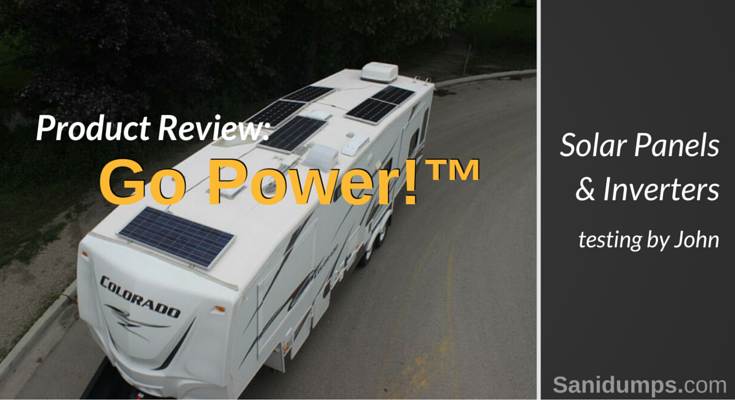
I had a question, did I need to buy the whole system at once?
This is my journey with solar panels and inverters for RVs since 2004. Chris (my wife) and I like to go RVing in national, provincial, and state campsites and these locations do not have electrical hookups at many locations. Many times we had to leave our campsites to get the batteries charged up and I thought there had to be a better way to extend our trip. We had a choice of going the generator method or the solar method, we decided on the solar method.
My first RV with solar had an 80 watt panel, since then I have had the following combinations of solar panels:
As you can see, I have mixed different sizes of solar panels together and there could be more panels in the future, as my current RV could hold another two or more panels on the roof.
When I had my first solar panel installed I advised the RV Dealer to upsize the wiring (to use a larger wire size) from the solar panel to the solar regulator as I had plans to add future panels to the roof. This decreases the power lost from the panel to the batteries due to wire size.
What I didn't do was make sure the location on the roof where the solar panel was being installed would easily allow for another panel beside it. Oops, when I installed the second solar panel I needed longer cables to make the connection to the first panel. If the first panel was moved about six inches I could have fit the second panel beside the first one. Why is this important? Careful planning can save installation steps later and longer wires introduce line losses that affect efficiency of the system.
Since the style of RVing Chris and I like to do is not always the full hookup style. We enjoy more of the get to know nature style where we would not have power, water, and sewer hookups. We decided to not go with the single twelve volt battery that a lot of RVs come with because of its limited amount of stored power. The choice we made was to go with four, six volt deep cycle batteries (also known as golf cart style) with the greater amount of stored power. This enabled us to go for long weekends not needing to charge the batteries.
I'm not going to cover the solar installation process here as KC has covered his solar installation and there's a good video showing the installation. I will add some notes throughout this report.
Notes from my installations:
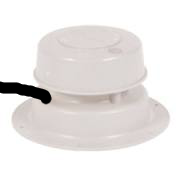
This image shows where I would run the wires through the sewer vent cap, the wires run down beside the vent pipe, not inside the pipe. Also, the location of the hole for the wires in the vent cap is not at the base of the cap.
(80 panel)
Our first solar panel was 80 watts and is considered a small panel by today's standards, but you will be surprised how much it helped. We didn't have a lot of electronics running, no TV, no microwave, etc. just a basic RV with four, six volt deep cycle batteries.
When RVing with no hookups to power, water, sewer, etc. we found that there were four things that could limit our stay:
On my very first RV, the only item that used battery power was the two lights. Today, there is a lot more battery demand for the furnace, fridge, water pump, many more lights, slides, jacks, carbon monoxide gas alarm, propane detectors, etc. For new RVs there is a need for a lot more battery power and I have not discussed the need for power for TVs, DVDs, etc.!
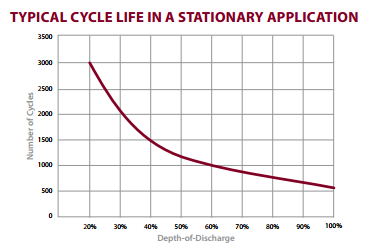
Another thing I learned was that the more you keep your battery charged up, the longer it will last. RV batteries generally should not be drawn below 50% of their capacity, or it will shorten the life of the battery.
This chart shows that a battery being used to 50% compared to the battery being used 20%, has less life cycles, a shorter life.
With the 80 watts solar panel we found that we could stay out longer before our batteries were drained down to 50%. :-) We still have to conserve our battery power but not like we had to without solar.
There is an article (RV Times) about Chris quilting at a campground with no power hookup, using a small inverter and our batteries with this 80 watt solar panel. No noisy generators required.
(80 + 110 panels)
We were very pleased with the 80 watt solar panel, can more be better? The decision to use more power to run some 120V AC power (shore power) devices such as the microwave, required us to install an inverter (converts battery power DC to shore power AC), the Magnum MS2812 2800 watt true sine wave inverter was our choice. This required us to add another solar panel since we were using more power, another 110 watt panel was added to join the 80 watt panel.
Our first small inverter was a modified square wave inverter, it could charge my laptop but the laptop brick (charging transformer) would run very hot and the laptop would take longer to charge up. KC has a great review of the Magnum inverter so I'm not going to repeat many of the same points here. I will make one very important note here, Chris loves the one button to turn the inverter off or on, it is very simple to use!
The 190 watt solar package enables us to now watch an old small black and white TV (garage sale special for $5) and Chris enjoyed being able to quilt for longer periods of time. We were also able to use the microwave to quickly defrost items for lunch while traveling on the road or for dinner.
With only the 80 watt panel I would always look for the campsite with the best view towards the sun, with 190 watts this was less critical.
(110 + 110 panels)
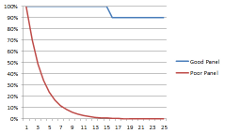
We sold our old RV and purchased another RV and made the following changes:
These solar panels have a 25-year warranty not like some cheep units that you can find that only last a few years. Also make sure you are dealing with a company that will be around, I've seen solar companies come and go and your long term warranty isn't of any value if the company is not there to support you!
Carmanah Technologies founded in 1996 offers a 25-year warranty for their solar panels that at 15 years the panel output is still 100% of the rated capacity, at 25 years the panel output is still 90% of the rated capacity. While some panels have a warranty that they can be 30% less effective after one year! The chart shows Go Power!™ warranty in blue and a poor warranty in red for rated output from the panel.
(110 + 110 + 120 panels)
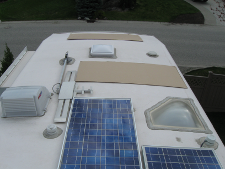
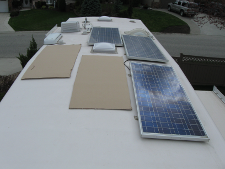
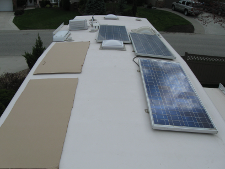
As you add more panels locations on the roof, roof space can become an issue. I use the cardboard cut-outs and my existing panels to lay out my panels before I drill a single hole or attach a single clamp. I learned my lesson with the first solar panel installation. The above images are of my RV with three solar panels and cardboard layouts planning for future solar panels. The image on the left and the right are possible options, the image in the middle is not a future option as it would restrict walking on the roof to clean the solar panels.
There is minimum maintenance required for maximum performance. Just wipe the solar panel with a damp cloth when they get dirty, this increases the amount of sunlight electricity entering the solar cell to produce more power.
We enjoy RVing in the early spring and late fall. During this time of the season the weather is not as warm, and we find we are running the furnace often in the mornings to warm up the RV from the cool nights. Many nights the temperature would go below freezing, but we were toasty warm in the RV. With 340 watts of solar panel we don't have to be concerned with running the batteries down, as we did before as our solar panels would have our batteries fully charged in the early afternoon. We also observed our batteries were drawn down less than 25% which significantly improves battery life.
(110 + 110 + 120 + 125 panels)
Chris teases me that I must want to sell power to our neighbours. Many days the batteries are fully charged by ten to eleven in the morning, we can watch a movie many nights in a row if we want to but most of the time we are reviewing our photography shots on the TV in the evening (yes, the black and white TV has been replaced, and it is better viewing the pictures on a large screen LCD TV then the tiny camera screens).
Remember the chart above about the cycles and battery life? I sold my original batteries after five years, and they were in great shape. Keeping your batteries fully charged and not having many deep cycles will extend the life of your battery.
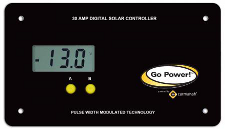
I have used three different solar regulators, or charge controllers. The regulator/controller maintains the life of the battery by protecting it from being overcharged. The first unit I had (rated at 20 amps) was a simple off/on type of regulator, it would sense if the solar power should be passed on to the battery or not, this is not the most efficient type and I would not recommend this type of solar regulator.
The second and third regulators were pulse width modulation (PWM) technology with a unique four stage charging system to charge and protect your battery bank. Pulse Width Modulation (PWM) is the most effective means to achieve constant voltage battery charging by switching the solar system controller's power devices. When in PWM regulation, the current from the solar array tapers according to the battery's condition and recharging needs.
My second regulator was rated at 25 amps and with 465 watts of solar power I exceeded the design of the regulator. The third regulator is rated at 30 amps.
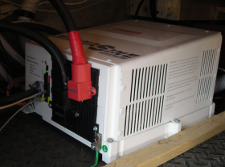
I have used several small square wave or modified wave inverters over the years. I have found that these type of inverters are not as efficient as a true sine wave inverter. A true sine wave inverter produces a wave the same as the power coming from your electrical outlet at home. I also found that chargers do not run very well when using modified wave inverters. The true sine wave inverter that I have used on two of my RVs is the Magnum MS2812, you can see KCs review of the Magnum MS2812 inverter.
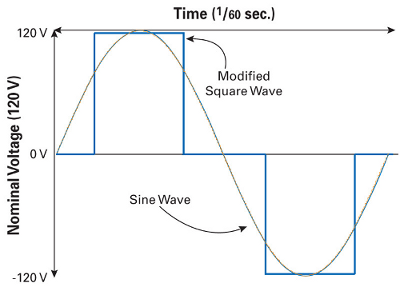
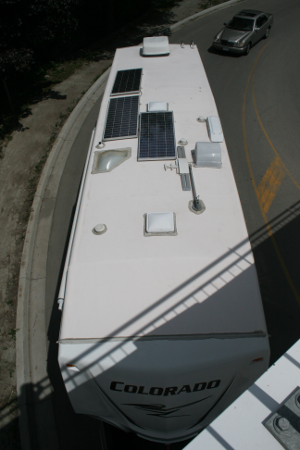
Will I add more solar panels?
You never know what lies ahead, so it is hard to answer the question. I am sure as we carry and install more electronics, the need for power will increase. I have met with many RVers who ask questions about solar. Everyone's RV lifestyle and power needs are unique and therefore require a unique answer.
RVing Lifestyle
- Full hookups
- Dry camping or boondocking
- Full time or weekender or somewhere in between
Appliances and Length of Use
- How often does the furnace run? This is a heavy power user!
- Do you need to run the air conditioner?
Locations Where You RV
- What latitude do you do most of your RVing? The further North, the more you will need.
Time of the Year and Length of Each Trip
- How often do you go RVing?
- What time of the year do you RV? Spring, Summer, Fall, Winter
- Weather, is it clear and sunny most of the time or is it cloudy?
- Is your campsite covered with trees or is it open to the sun?
- Is there snow on the roof while you are RVing?
- How do you store your RV during the winter months?
Costs
- Do you need to run medical devices through the night?
- How well do you conserve power or do you want power at any cost?
- Do you like running a noisy generator?
Basically, what are your power needs? This Calculator can help you calculate your solar needs.
I have found the staff at Carmanah Technologies are very helpful.
If there is one advice I would like to share is that you do not need to buy the whole system at once, I started with one 80 watt solar panel and grown to four panels with 465 watts of solar power, you can add on as your needs change or budget permits. My inverters started with cheap square wave inverters and grown to a quality true sine wave inverter. With the pricing of solar these days, you can even save some money as they seem to be getting cheaper every year.
Yes!
I would have gotten into using solar sooner. The joys of life are important, if you have seen me presenting seminars you will know that one of the last slides in the presentation is of some of the scenic pictures we have taken while RVing.
Solar has helped Chris and I enjoy the life of RVing.
(120 + 125 + 160 + 160 + 160 + 160 panels)
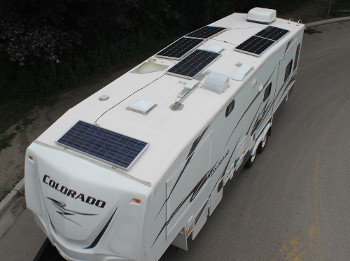
The future is here, I now have 885 watts of solar power on the RV roof and I have changed the solar regulator to an MPPT type. Watch for my review in the future.
Here's a picture of the roof of my RV with 885 watts of solar panels.
(120 + 125 + 160 + 160 + 160 + 160 + 160 panels)
I had an extra 160-watt solar panel in the basement of our house, and I had space on the RV so let's install it. Actually I had plans to install this panel for a few years, I didn't get around to it as the installation would require running some more wires from the roof of the RV to the basement, this is not an easy task doing it by yourself.
My son-in-law was visiting for a few days, and we had a window of opportunity, so I took advantage of his help.
Before installing this last panel, I had all the solar panel connected in series (not parallel), adding this panel would require that I put the solar panels in two loops of series (making a series/parallel connection), this would prevent maxing out the total voltage on the solar regulator (MPPT type).
Wasn't 885 watts enough? Yes, but we are doing more and more RVing in the colder period of the year and the sun, if it is shinning is lower on the horizon. Not the best situation for solar, but I do not like hearing the generator running, I rather listen to nature.
I have experience with using solar from only 80 watts of power to now 1045 watts. I also receive many questions while at seminars and on the road about solar, with this full range of solar use I believe I can answer most RVers questions.
There have been times when RVing with friends (without solar) and they had drained their batteries very low, to help them out, I had them plug their RV into our RV like you would do when at home or when connected to power at a campsite. My RV, running solar would charge their batteries, and we could extend their stay.
I have always used Go Power!™ products, my journey with their products started back in May 2004. Go Power!™ started advertising with Sanidumps.com in March 2011.
Go Power!™ by Carmanah Technologies
250 Bay Street,
Victoria, British Columbia,
Canada, V9A 3K5
Toll-free: 1.866.247.6527
Fax: 1.866.607.6527
Email sales: sales@gpelectric.com
Website: gpelectric.com
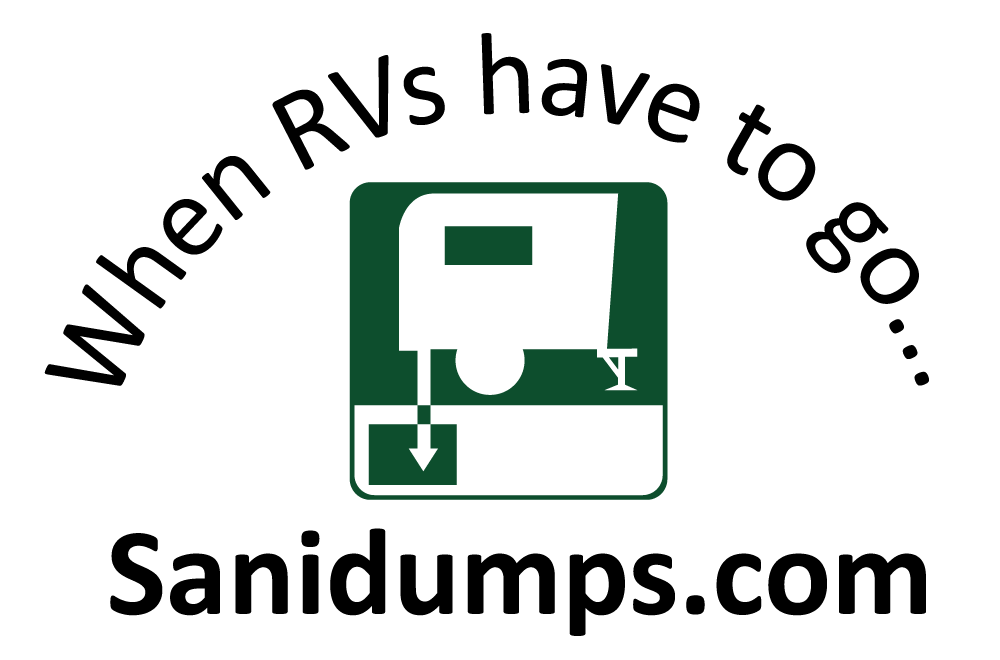
National Day Calendar
✔ Mark your calendar,
June 7 is
National RV Day,
Let's go RVing!
The type of recreational vehicle dump stations you will find on Sanidumps.com include: private, public, RV park, non-park, municipal, truck stop, rest stop, campground, camping, resort, commercial, pay, donation, waste disposal, and free.
It is important to dispose of human waste properly when RVing. The RV dump station, dump point, or sanidump station you choose to empty your gray and black water holding tanks is up to you; we're hoping that you will choose an approved dump station site that's green and environmentally friendly, using an environmentally sound method.
Do you need to know where to dump your holding tanks when your RV is on the road? Now you can know where the RV dump Stations are while traveling with a e-book. More information about the RV Dump Station location e-book.
Although efforts are made to make sure of the accuracy of the information presented, Sanidumps.com shall have neither liability nor responsibility to any person or entity with respect to any loss or damage caused, or alleged to be caused, directly or indirectly by the information contained here.
Sanidumps.com is not affiliated in any way with any place/location listed on this site. Fees are subject to change; availability and prices can and do change.
We thank all the RVers that have contributed information :-)
The Sanidumps.com Team
Serving the RV community for over 18 years
Sanidumps.com - When RVs have to go...™
© 2006 - 2024 Sanidumps.com - All rights reserved.
The content contained on this website may be used for personal reference only and may not be reproduced in any form without prior written consent permission from Sanidumps.com
Australia, Canada, Mexico, New Zealand, United States & more...